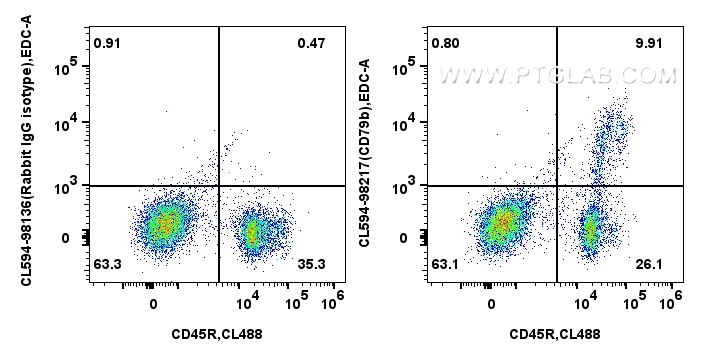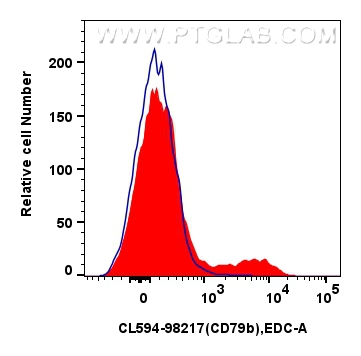验证数据展示
经过测试的应用
| Positive FC detected in | mouse bone marrow cells |
推荐稀释比
| 应用 | 推荐稀释比 |
|---|---|
| This reagent has been tested for flow cytometric analysis. It is recommended that this reagent should be titrated in each testing system to obtain optimal results. | |
| Sample-dependent, Check data in validation data gallery. | |
产品信息
CL594-98217 targets CD79b in FC applications and shows reactivity with mouse samples.
| 经测试应用 | FC Application Description |
| 经测试反应性 | mouse |
| 免疫原 | Recombinant protein 种属同源性预测 |
| 宿主/亚型 | Rabbit / IgG |
| 抗体类别 | Recombinant |
| 产品类型 | Antibody |
| 全称 | CD79B antigen |
| 别名 | 241850D10, B-cell antigen receptor complex-associated protein beta chain, B-cell-specific glycoprotein B29, Igb, Ig-beta |
| 计算分子量 | 26 kDa |
| GenBank蛋白编号 | NM_008339.3 |
| 基因名称 | Cd79b |
| Gene ID (NCBI) | 15985 |
| 偶联类型 | CoraLite®594 Fluorescent Dye |
| 最大激发/发射波长 | 588 nm / 604 nm |
| 形式 | Liquid |
| 纯化方式 | Protein A purification |
| UNIPROT ID | P15530 |
| 储存缓冲液 | PBS with 0.09% sodium azide , pH 7.3 |
| 储存条件 | Store at 2-8°C. Avoid exposure to light. Stable for one year after shipment. |
背景介绍
CD79 molecule encompasses two transmembrane proteins, CD79a and CD79b, which form a disulfide-linked heterodimer and are members of the immunoglobulin (Ig) gene superfamily (PMID: 2033258; 1375264; 2304550). CD79b molecule (also known as B29, IGB, AGM6, and Igbeta) is expressed almost exclusively on B cells and B-cell neoplasms, influencing antigen internalization and increasing antigen presentation efficiency (PMID: 7552998). CD79b mutation could be a key biomarker for DLBCL disease progression (PMID: 36182550).
实验方案
| Product Specific Protocols | |
|---|---|
| FC protocol for CL594 CD79b antibody CL594-98217 | Download protocol |
| Standard Protocols | |
|---|---|
| Click here to view our Standard Protocols |

